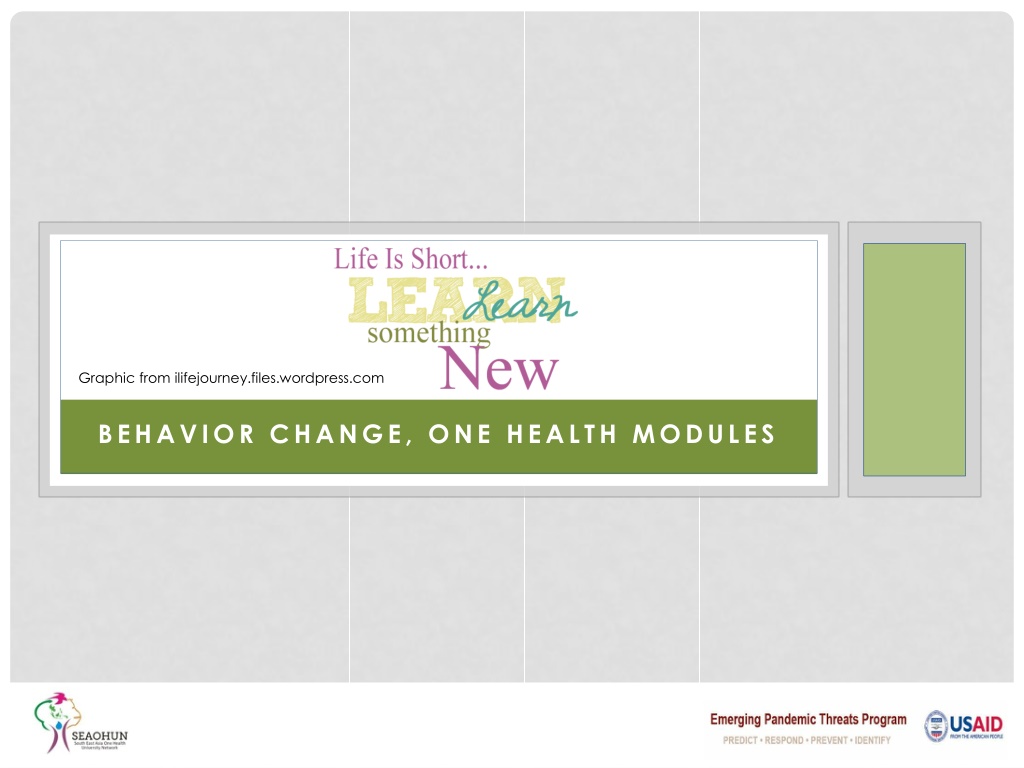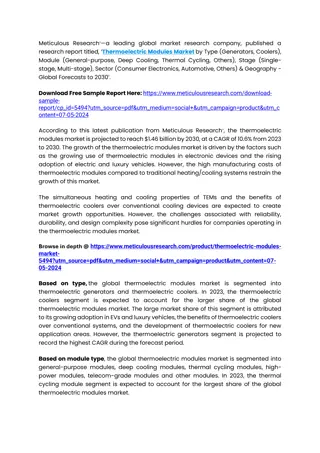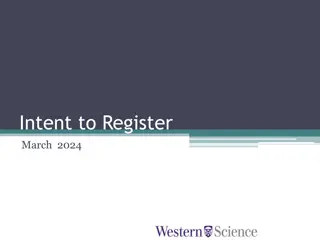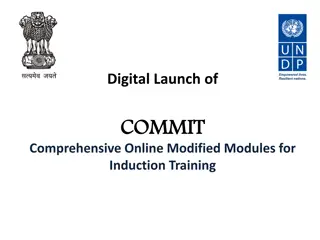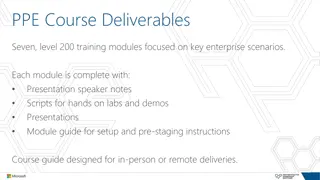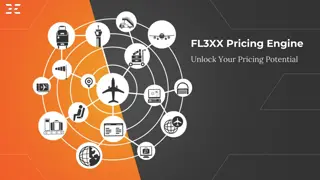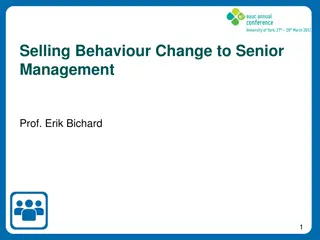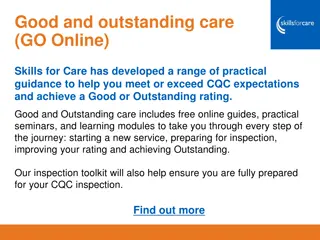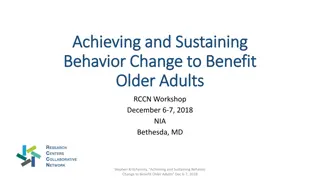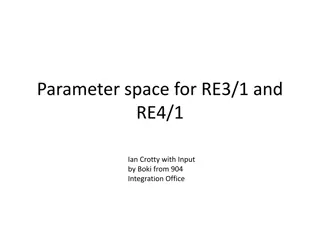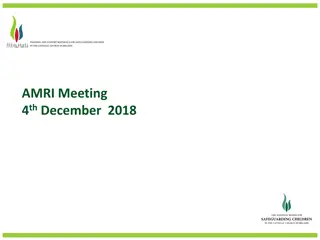Behavior Change and Health Modules Overview
Explore behavior modification theories, change management concepts, and competency modules to design effective behavior modification strategies for occupational health interventions in communities. Learn the difference between professional-directed and patient-centered behavior change approaches through practical exercises. Enhance your skills in leading change and fostering cultural competency for successful outcomes in one health initiatives.
Download Presentation

Please find below an Image/Link to download the presentation.
The content on the website is provided AS IS for your information and personal use only. It may not be sold, licensed, or shared on other websites without obtaining consent from the author. Download presentation by click this link. If you encounter any issues during the download, it is possible that the publisher has removed the file from their server.
E N D
Presentation Transcript
http://mispronouncedname.files.wordpress.com/2013/05/learn_something_new.gif?w=812http://mispronouncedname.files.wordpress.com/2013/05/learn_something_new.gif?w=812 Graphic from ilifejourney.files.wordpress.com BEHAVIOR CHANGE, ONE HEALTH MODULES
Introduction BEHAVIOR CHANGE, ONE HEALTH MODULES
MODULE COMPETENCIES Competency #1 Explain behavior modification theories and change management concepts Competency #2 Adapt models for individual behavior change for OH initiatives across a range of stakeholders Competency #3 Demonstrate cultural competency and professionalism in leading change Competency #4 Design behavior modification strategies for OH interventions in communities
MODULEOVERVIEW Time/Length Topic -- Prework 30 minutes Introduction 60 minutes 60 minutes Introduction to Behavior Change Moving from Professional Centered to Patient Centered Behavior Change 60 minutes Health Belief Model 120 minutes Two Models for Patient Centered Change: Motivational Interviewing and RULE Expanding the Motivational Interviewing and RULE Models beyond a Health Care Setting Two Models of Organization and Community Change: Kotter and Lewin 120 minutes 90 minutes 150 minutes Behavior Change in One Health Interventions Module Review 60 minutes
http://preview.cutcaster.com/901681760-Change-Ahead-Yellow-Sign.jpghttp://preview.cutcaster.com/901681760-Change-Ahead-Yellow-Sign.jpg When was the last time you did something for the first time
Professional-Directed vs. Patient-Centered Behavior Change BEHAVIOR CHANGE, ONE HEALTH MODUELS
PRACTICE EXERCISE In trios randomly select a role Two 10-minute rounds Patient and Change Agent 1 Patient and Change Agent 2 After each round Patient writes down on a scale from 1 to 10 how likely they are to change their behavior Discuss what was effective about the Change Agent s approach Discuss what was not as effective about the Change Agent s approach
WHAT DO YOU THINK? Which approach was most effective? Which approach is most natural to you? What skills do both approaches have in common? What skills did you see Change Agent #1 using? What skills did you see Change Agent #2 using? Which from a patient s point of view is most effective?
Models of Patient-Centered Behavior Change Health Belief Model BEHAVIOR CHANGE, ONE HEALTH COURSE
THE HEALTH BELIEF MODEL Developed by a group of social psychologists at U.S. Public Health Service in the 1950s. Derived from psychological and behavioral theory. Objective was to explain why people were not participating in a tuberculosis screening (disease detection). One of the first models developed to specifically address health-related behaviors. The model has been modified to apply to a greater amount of situations.
THE HEALTH BELIEF MODEL Ultimately, an individual s course of action depends on an individual s perceptions of the benefits and barriers related to health behavior.
HEALTH BELIEF MODEL CONSTRUCTS For a patient to change behavior, patient must: Know that they are susceptible to or have a particular health condition Believe that having the condition is serious and harmful Perceive that the benefits of changing their behaviors outweighs the challenges Feel that there are treatment options Feels a call to action to spark the change Perceives that s/he can successfully preform the behavior
HEALTH BELIEF MODEL: SIX CONSTRUCTS Patients perception that they are susceptible to or have a particular health condition. Perceived Susceptibility
HEALTH BELIEF MODEL: SIX CONSTRUCTS Patients belief that having the condition is serious and harmful. Perceived Severity
HEALTH BELIEF MODEL: SIX CONSTRUCTS Patients perception that actions will result in a benefit (a reduction in the threat of the illness or disease or the curing if the illness or disease). Perceived Benefit
HEALTH BELIEF MODEL: SIX CONSTRUCTS Patients perception that the benefits of changing their behavior will outweigh the challenges and obstacles of making the change. Perceived Barriers
HEALTH BELIEF MODEL: SIX CONSTRUCTS Patient feels a call to action to spark the change process. Cue to Action
HEALTH BELIEF MODEL: SIX CONSTRUCTS Perceives, or has the confidence, that s/he can successfully preform the behavior Self-Efficacy
MODIFYING FACTORS IMPACTING LIKELIHOOD FOR CHANGE
WHAT DO YOU THINK? What do you see as the strengths of the health belief model? What do you see as the limitations of the health belief model?
Making the change Quitting Smoking Not making the change Continuing to Smoke Benefits Costs Benefits Costs Won t cough in the morning Stressful to quit Helps with stress Worry about health More energy Gain weight Enjoy smoking with friends Social Stigma Save money Lose another pleasure Ruins skin Better role model for kids Withdrawal symptoms Cannot smoke at work or in the house Get winded and cannot do some activities
Models for Patient-Centered Behavior Change Readiness to Change and Motivational Interviewing BEHAVIOR CHANGE, ONE HEALTH MODULES
Importance Ruler Somewhat Important Very Important Not Important Confidence Ruler Somewhat Confident Very Confident Not at all Confident Readiness to Change Ruler Somewhat Ready Very Ready Not Ready
WHAT DO YOU THINK Given what you read about Motivational Interviewing: How do you think asking about readiness or importance or confidence to change will help people change their behavior? How do you think you might use this?
Spirit of Motivational Interviewing: ACE Honor the patient s choice about change. Often, acknowledging a persons right and freedom to choose NOT to change, frees them up to consider change. A Autonomy C Collaboration E Evocation Create a safe, collaborative environment and encourage/facilitate joint decision- making and problem solving. Evoke or draw out patient s own ideas and motivation for change. Understand their own perspectives, uncover values and goals that support health behavior change. Guiding Principles of Motivational Interviewing: RULE People generally believe what they hear themselves say they should do & react in opposition of what others tell them to do. The patient is his/her own expert. R Resist the Righting Reflex U Understand your Patient s Motivations L Listen to your patient It is the patient s own reasons for change, and not ours, which are most likely to trigger behavior change. When it comes to behavior change, the answers most likely lie within the patient and finding them requires listening and discovery (like panning for gold). The patient who is active in the consultation, thinking aloud about the way and how of change, is more likely to follow through. E Empower your Patient
KEY SKILLS OF MOTIVATIONAL INTERVIEWING Empathizing Asking Questions Listening Informing Current Skills Accept- able Where I want to be Accept- able Skill Poor Good Great Poor Good Great Empathizing O O O O O O O O Asking questions Listening O O O O O O O O O O O O O O O O O Informing O O O O O O O
MOTIVATIONAL INTERVIEWING AND RULE REQUIRE: Using open-ended questions to explore patients feelings Affirming comments and behaviors that show signs of increased interest in change Exploring the benefits and drawbacks of making the change Having the patient envision a future and ask what needs to happen to achieve that future
Two Models for Organization and Community Change: Kotter and Lewin BEHAVIOR CHANGE, ONE HEALTH COURSE
KOTTERS 8 ESSENTIAL STEPS FOR CHANGE Establishing a Sense of Urgency Creating a Guiding Coalition Developing a Vision & Strategy Communicating the Change Vision Empowering Broad-Based Action Generating Short-Term Wins Consolidating Gains & Producing More Change Anchoring New Approaches in the Culture
LEWINS THREE STEP MODEL FOR CHANGE http://www.web-books.com/eLibrary/Books/B0/B58/IMG/fwk-carpenter-fig07_013.jpg
WHAT DO YOU THINK? What they liked about each model. What they need to study more about each model. Are the models exclusive of each other? Complimentary?
Expanding Patient-Centered Behavior Change Models Beyond the Human Health Context BEHAVIOR CHANGE, ONE HEALTH COURSE
http://ecx.images-amazon.com/images/I/31QqPc2sGkL._AA220_.jpghttp://ecx.images-amazon.com/images/I/31QqPc2sGkL._AA220_.jpg How would the health belief model work in your region, culture, or discipline? http://ecx.images-amazon.com/images/I/31QqPc2sGkL._AA220_.jpg How would you modify Motivational Interviewing and RULE to work in your region, culture or discipline?
WHAT DO YOU THINK? Are there any similarities in your models that we see cutting across regions/cultures or disciplines? What are the differences across regions, cultures and disciplines that we need to be aware of and sensitive to when working as part of a One Health team? How do you think understanding these similarities and differences in approach will help you in your work?
BUILD YOUR TOOLKIT As a member of a One Health Team, what do you feel is your role in changing people s behaviors? Create your model for behavior change in your discipline and as part of a One Health team.
Behavior Change in One Health Interventions BEHAVIOR CHANGE, ONE HEALTH COURSE
WHAT DO YOU THINK? Think of a situation that you have faced or might face that involves changing individual and/or community behaviors. What is your model for change? Directions: Spend the next 30 minutes reflecting on your ideas from the previous session in which you created your own personal model for behavior change and the two models for community change Kotter and Lewin. Summarize your model of a flipchart. At the end of the hour, we will share our models.
http://www.payology.com/wp-content/uploads/2011/02/change-wordle.jpghttp://www.payology.com/wp-content/uploads/2011/02/change-wordle.jpg Graphic from www.payology.com
Learning Reflections and Evaluation BEHAVIOR CHANGE, ONE HEALTH COURSE
ONE THING.. That you liked/felt was a strength of the module. That you would suggest we change. Thank you.
This publication was made possible in part through the support provided by the United States Agency for International Development. The opinions expressed herein are those of the author(s) and do not necessarily reflect the views of the US Agency for International Development or the US Government. USAID reserves a royalty-free nonexclusive and irrevocable right to reproduce, publish, or otherwise use, and to authorize others to use the work for Government purposes.
